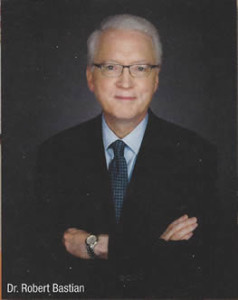An Interview with Dr. Robert Bastian
In 2015 I had the opportunity to interview Dr. Bastian for Classical Singer Magazine regarding Vocal Surgery, myths and more. Here is part one that interview:
When Dr. Robert Bastian was studying medicine, he was taught to “never operate on singers.” But in his early years of practice, he began to question that prevailing dictum. Now highly revered for his 25-year career treating singers, Dr. Bastian discusses how attitudes about surgery have evolved, when he feels surgery is necessary and what the positive and negative effect are, what he considers the major vocal myths, and why voice teachers need to be well educated when it comes to surgery and vocal health.
Robert W. Bastian, M.D., founded the Bastian Voice Institute in 2003. Previously, he reached the rank of professor in the Department of Otolaryngology at Loyola University in Chicago and maintains a current affiliation there as clinical professor of otolaryngology. For more than 25 years, Dr. Bastian’s work has focused exclusively on voice, swallowing, and airway disorders. Particular areas of interest include vocal fold microsurgery with a lifetime caseload estimated at more than 4,000, or which more than 1,000 are singers.
In addition, Dr. Bastian follows noteworthy caseloads of patients with spasmodic dysphonia and adult recurrent respiratory papillomatosis. He is known as we as a pioneer of modern office-based surgical procedures, including use of the pulsed-KTP and thulium lasers. Other areas of expertise include swallowing disorders, nonorganic voice and airway disorders, and laser and other surgeries for larynx and pharynx cancer.
On a fall morning at the Bastian Voice Institute, I had the privilege of talking with Dr. Bastian. I have worked with him on numerous cases of pre- and postoperative voice-disordered singers. He was the first to explore new techniques in operating on singers, and his efforts and results forever changed the paradigm of singers and vocal fold surgery. What follows is a lightly edited version of our conversation.
RB: How and why did you start performing surgery on singers?
 DrB: As a background, the dictum in residency was “Never operate on singers – you’ll make them worse.” I don’t think I ever saw a surgical procedure in a singer during my training. In addition, at the voice meetings I attended around the time, speech therapy and singing therapy seemed to be generally viewed as the entire answer to vocal fold injuries. I don’t remember any dissenting opinions and so I initially accepted this. But soon my experience began to throw this belief system into question.
DrB: As a background, the dictum in residency was “Never operate on singers – you’ll make them worse.” I don’t think I ever saw a surgical procedure in a singer during my training. In addition, at the voice meetings I attended around the time, speech therapy and singing therapy seemed to be generally viewed as the entire answer to vocal fold injuries. I don’t remember any dissenting opinions and so I initially accepted this. But soon my experience began to throw this belief system into question.
RB: What, for example, shook your confidence in the prevailing wisdom?
DrB: First, I had a colleague who had undergone vocal fold microsurgery in Europe and said it was extremely successful in restoring [his] singing voice. This piqued my curiosity. Second, the stroboscopy examinations I was doing at the time began to teach me that lengthy speech therapy didn’t fully resolve some injuries. Such persons were sometimes told elsewhere that the problem had resolved or maybe that the voice was growing and maturing (“I’m really a spinto.”).
I learned that some singers were working mightily to view their improvement to be complete resolution. And they continued to search for that last “technical” solution to vocal limitations. Yet, when I applied high-range “boy-soprano” pianissimo “swelling checks” to voices that were said to be recovered, I still heard considerable impairment. And videostroboscopy performed during phonation at extremely high pitch showed ongoing injury.
And, finally, in response to the many questions I asked such individuals, I began to understand that the most revealing symptom of mucosal injury was not hoarseness, but instead one or more of the following: day-to-day variability of capability, increased effort, reduced vocal (mucosal) endurance, loss of high pianissimo, and phonatory onset delays. Such symptoms of mucosal injury were sometimes mistakenly considered to be technical, because technical refinements could reduce or conceal them.
RB: So how did these observations lead you to doing surgery in singers?
DrB: It was step-wise. I had found Dr. Kleinsasser’s classic book on vocal fold microsurgery one day during residency, tucked away in the library. It was a startling revelation. Through that book, I was introduced to microsurgical instruments that I had never previously seen. Later, using such instruments, I began – very cautiously and only after the singer had undergone lengthy therapy (at least six months back then) – to offer the option of microsurgery. The first few were those who could not accept or work around their impairment after months or years of trying.
To my surprise (and enormous relief), the voices of the first few singers were restored to a remarkable degree. Vibratory ability and match between the folds returned to normal, along with the voice’s capabilities. Because the surgery was precise and superficial, there was not detectable scarring under stroboscopic examination, even at C6 for soprano voices.
The last step that really settled my commitment to vocal fold microsurgery as an option in the rehabilitative realm was a single day I spent in the operating room with a wonderful surgeon and fine man, Dr. Marc Bouchayer, in Vénissieux outside of Lyon, France. As I recall, I saw him do five cases in a morning and also had good conversations with him about his experience with surgery in singers. During that visit, everything went “click.” All of this gave me the courage to swim against the current.
RB: Describe what it was like to swim against the current.
DrB: An anecdote will illustrate: Maybe a year or two later, I was invited to be on a panel on vocal fold microsurgery in singers. I was already feeling embarrassed and out of place due to my youth. Then, to my dismay, at the end of the panel someone asked, “Could each panelist tell us how many singers you have operated on?” I was astonished to learn, together with the audience, that the rest of the panelists, combined, had only operated upon one singer. I was that last one in line and was forced to answer, “I’ve done nine singers.”
In retrospect, I think this was perceived as “knife happy” both because of my youth and because ot so conflicted with the belief systems in the room. The audience didn’t know how slowly, carefully, and cautiously I had proceeded, and I think it took years to overcome this undeserved reputation.
Yet, having subsequently performed surgery in many hundreds of singers, I have come to see that the very small risk of surgery (for nodules, polyps, and capillary ectasia) must be balanced against what can be a huge risk of life purposes and even career of not doing surgery when confronted by otherwise – irreversible lesions.
RB: Why was surgery seen as so potentially dangerous to singers?
DrB: If surgeons at the time didn’t routinely assess results with videostroboscopy, and if in addition they didn’t know vibratory dynamics and vocal fold microarchitecture, then they didn’t have the kind of understanding and tools for self-criticism to do safe vocal fold microsurgery. It is easy to ruin vocal folds without this knowledge – and fairly straightforward to restore vocal folds (especially for nodules and polyps) with this fund of knowledge.
RB: What was the surgical technique of the time?
DrB: There would have been lots of differences between surgeons, just as there are today. Surgeons such as Dr. Bouchayer were already doing wonderfully precise surgery. Yet, it was still common at the time (and, in fact, was part of my residency training) to use a technique known as vocal fold stripping: you grasp the mucosa just in front of the lesion (polyp, nodules) with forceps. You turn the forceps to break the mucosa and you pull along the line of the fold. This, in turn, peels the mucosa away.
The problem is that it can be both overly generous and only semi-controlled. Or, in the early days of lasers, the spot size was very large and the zone of thermal injury even larger – and, especially without the fund of knowledge mentioned above, you could scar the folds.
Check back with me soon for part two of this informative interview.


1 thought on “Vocal Surgery, Myths and More Part 1”
Comments are closed.